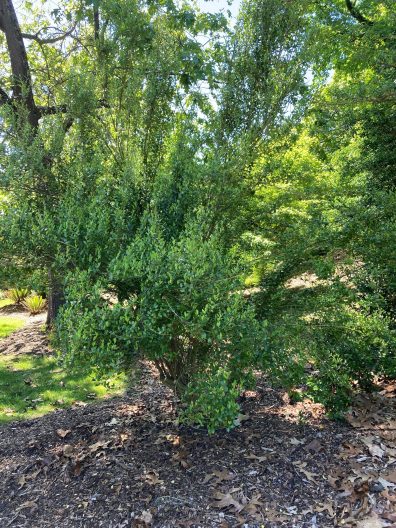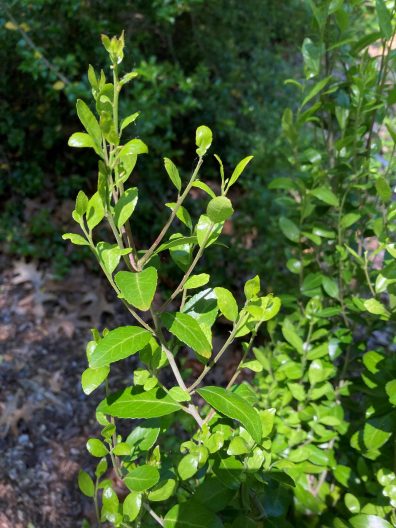June Plant Profile: Ilex vomitoria

Let’s be honest, Ilex vomitoria, AKA yaupon holly isn’t much to look at. Not that it’s a bad looking plant, it’s just kind of nondescript…the sort of thing you’d buy at a big box nursery if you wanted to grow a nice, sturdy hedge. It serves a purpose in an ornamental landscape, but it’s unlikely to be the centerpiece of a garden or anyone’s favorite plant. There are some varieties that may add a little interest to an otherwise dull plant: ‘Helleri’, ‘Will Flemming’, ‘Pendula’, ‘Pride of Huston’, etc. While the yaupon holly isn’t a particularly interesting specimen to look at for most folks, it has an interesting story. But let’s get through the boring parts first:
Ilex vomitoria is an evergreen member of the holly family (Aquifoliaceae), native to the SE United States. Its natural range is from eastern Texas, along the Gulf Coast, through the Florida panhandle and the north of the state, up along the Atlantic Coast to North Carolina. The common name, yaupon is derived from the Indigenous Catawban word for small tree or leaf of the tree, yop or yapa. Within its natural range, Ilex vomitoria is an important food source for a variety of animals. Many birds and mammals consume the berries, deer browse the twigs, insects are attracted to the flowers’ nectar and the plant is a larval host for Henry’s Elfin butterfly. The structure of the holly makes it a suitable nesting and shelter site for smaller birds.
Visitors to the Arboretum can find our rather forlorn looking specimen in a berm in the Ilex collection, not far south of Boyer Street, on the west side of Lake Washington Blvd. Because hollies are dioecious, our male collection plant won’t produce berries, resulting in a plant that’s even more prone to fade into the “green wall.”

Now for the cool stuff: the specific epithet “vomitoria” may give you a clue to something worth investigating…you don’t need to be a Latin scholar for the name to evoke thoughts. Traditionally, Indigenous peoples throughout yaupon holly’s native range make a tea by roasting the leaves and steeping them in water, possibly with other herbs. The resulting drink goes by several names (beloved drink, cassina, big medicine, and black drink by colonizers) was used in cleansing and pre-battle rituals. When large amounts of tea were paired with the fasting that was also part of these rituals, the result was vomit. Apparently lots of it. European colonizers witnessed the mass barfing and assumed that it was caused by the yaupon holly’s leaves, hence the epithet “vomitoria.” According to multiple sources, including the USDA Natural Resources Conservation Service website (1), Ilex vomitoria has no emetic properties, making the species name a misnomer. The emetic effect of the tea may have been caused by the aforementioned “other herbs” or other aspects of the rituals, but ultimately the cause can only be guessed at.
While yaupon tea may not cause puking, its positive energizing effects can be explained by the fact that it is one of only two studied North American native plants that contain caffeine; the other being Ilex cassine, or dahoon holly (We have three of the mexicana variety in our collection). Ilex vomitoria tea contains about 60mg of caffeine per cup, or about 1/3 of a cup of coffee; dahoon holly considerably less. Readers are likely to be more familiar with our native holly’s caffeinated and much more popular South American cousin, Ilex paraguariensis, AKA yerba mate which contains about 30% more caffeine than yaupon tea.
Yaupon tea, made only from the roasted plant’s leaves is actually pretty tasty, according to me…and I don’t generally drink tea. It has a unique, smoky flavor that’s quite pleasant if you’re into that kind of thing and it does have enough “boost” to be noticeable. While it is illegal to harvest plant material from the Arboretum, yaupon tea is much more readily available than it was a few years ago and can easily be sourced from specialty shops and online if you want to give it a try and/or to wow your friends with your vast botanical knowledge over a cup. Bottoms up!
Literature Cited
USDA Yaupon Plant Guide: https://www.nrcs.usda.gov/plantmaterials/etpmcpg13460.pdf